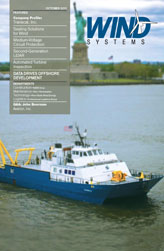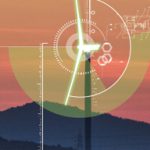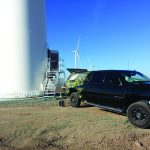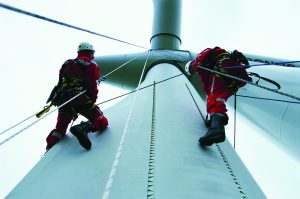What if a wind turbine could change its shape with varying wind conditions to optimally capture the most power from the wind at each wind speed? What would these shape changes be, and what would the impact be on the cost of energy? These questions were the premise of a study conducted at Penn State by a former aerospace engineering student Leo Albanese, Professor Farhan Gandhi, and myself.
In the push for more environmentally friendly ways to produce energy, wind turbines are poised to make up a significant portion of this expanding market. However, many improvements in turbine technology are being examined in order to make these machines more productive, safer, and with a longer design life. One concept for designing blades is through adaptive blade technology that may allow more energy to be captured and lower blade loads to be experienced. In theory these changes could result in a lower cost of energy to be produced, which results in turbines being more economical in more situations. While research has gone into blade geometry changes that result in reduced loads being produced, not much (besides extendable radius blades) has gone into technology that directly increases energy production. The study provided an investigation into what types of adaptable geometry blades have potential for extracting increased energy from the wind flow. A tool using Blade Element Momentum Theory was developed in order to simulate different geometry changes on two research turbine models. Parametric studies were performed on design variables of two turbine designs to evaluate these variables’ effects on power production and annual energy production for a specific wind resource condition. Finally, a study was performed combining the results of the power study with the results of a root bending moment study to see what blade configurations can maintain turbine power production while reducing blade root bending moments.
The two configurations studied were the WindPACT study 1.5MW turbine and a turbine design that resulted from an NREL study on 5MW configurations. Changes were made to the baseline twist distributions, root pitch settings, chord distributions, radial span, and airfoil characteristics at Region II wind speeds of 4, 6, 8, and 10 m/s. Each change was also simulated at a range of rotational speeds to ensure that if the geometry change altered the rotational speed at which optimal results occurred, the new optimums would be found. Also, each change that was examined made use of the baseline blade distributions scaled larger or smaller while keeping the other characteristics as unchanged as possible. Geometries that were optimal at each wind speed were then determined.
Some general trends were found in the results. Relative improvement in performance (or 3 percent improvement on an annual energy production basis) was found in varying the cross sectional characteristics and rpm at the lower wind speed of 4 m/s, however lower rpm startup conditions may limit the implementation of geometry changes for this operation range. As expected, changes in radius allowed for the most drastic increases in annual energy production on the order of 23 percent. However, with increased radius there are increased turbine loads that must be considered. Therefore, this study also calculated bending moments for the various design configurations. The study also examined the combination of pitch control with the geometry changes of twist value, chord variation, and radial expansion. This was done because it was noticed that adding positive pitch to the baseline blades decreased the bending moments produced, as well as the power produced. If the losses of power could be mitigated by the previous geometry changes while still realizing losses in bending moments, this would be very beneficial. At the rated speed of each turbine (where peak bending moments occur for each blade), each study produced root bending moment decreases of close to 10 percent or more for the 1.5MW turbine while at least maintaining power production. In fact, the radius study for this turbine saw bending moment decreases on the order of 14 percent. Larger decreases were available in some cases at speeds lower than the rated speed, showing promise for load reduction across the entire operating range. The 5MW turbine saw more modest results; the twist and radius studies saw bending moment reductions of 5 and 6 percent respectively, while the chord study could not produce a single result with negative changes in root bending moment while maintaining power production.
While much more work is needed to refine these concepts in order to come up with a useable geometry, the groundwork has been laid for this type of adaptive geometry blades to make an impact on wind turbine cost of energy.




































